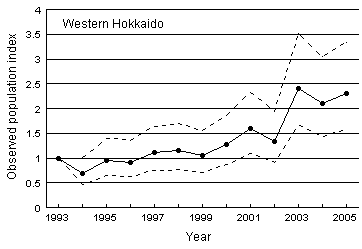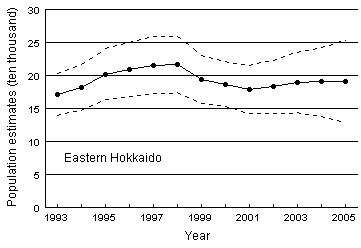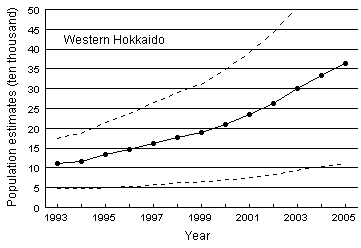Population increase in Hokkaido Island
The number of sika deer is increasing in Hokkaido Island, especially in the eastern area, causing serious damages on agricultural products such as grass; the amount of damage became 4600 million yen in 1997. Hokkaido government constructed a managing plan for sika deer in the eastern part of the island in 1997. The managing plan was then enlarged over the whole island in 2000. In 2008, the third phase of the managing plan started. Thus, the managing action is now arriving at one of its critical points.
Estimation of population index
Hokkaido government is using population indexes that are defined by the population divided by that of 1993, since most observation of population started at 1993. Several indexes are calculated from various sources including the spotlight survey, the data of catch per unit effort (CPUE), the amount of agricultural damage, and the helicopter survey. Among these, the index calculated from spotlight survey seems most reliable. In performing spotlight survey, investigators search deer by using spotlight from a vehicle moving slowly along the survey routes. We estimated the index by using generalized linear mixed model (GLMM) from the data obtained from spotlight survey. The results are shown in Fig. 1.

Estimation of population
We should estimate the absolute population from the index to determine the number of deer we should kill. We adopted the harvest-based estimation for this purpose. The number of killed deer has been recorded in each year. We can judge that the absolute population is large if the population index is not influenced by the deletion of a given amount of deer. We can inversely judge that the absolute population is small if the population index decreased by the deletion of a given amount of deer. We can thus estimate the absolute population by using the record of the number of killed deer; it is called the harvest-based estimation.
We encounter here a problem in performing the harvest-based estimation; the observed indexes contain observation errors. The probability of observation changes depending on the year. Hence, we adopted the state-space modelling to harvest-based estimation. We cannot directly observe the true number of deer (true state); the observed quantity lies in a space that is somewhat distant from the true state. We can obtain the maximum likelihood estimates of parameters in the state-space model by iterative calculations. However, the estimation of the standard errors is difficult in our case. Hence, we adopted Bayesian estimation as an approximation of maximum likelihood estimation. The results are shown in Fig. 2.
The change of population is much smoother than the change of index shown in Fig. 1. Thus, it is indicated that the probability of observation widely fluctuates from year to year.

